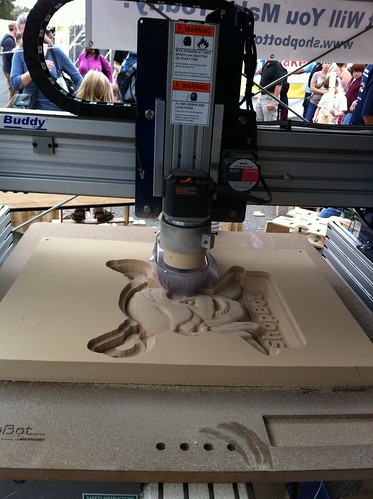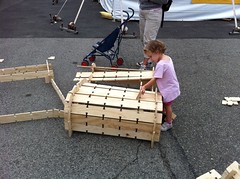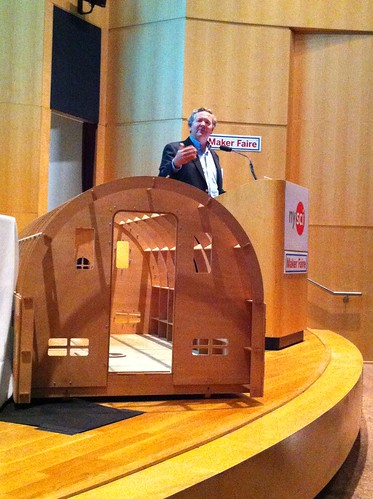Though it’s been a couple weeks since my trip to Maker Faire, I still haven’t shared a number of interesting things from this and the conference the following day. First of all, I need to share one of the coolest must-have things at the Faire. The ShopBot. This is truly a transformative device, and is any carpentry geek’s dream come true. Put simply, it’s a wood CNC machine. Even more simply, it’s a router, dust vacuum and platform with a USB plug. And it can turn your dreams into real plywood in no time flat. Here, you can see it doing a number on some MDF – 3D shapes very easily done. The price? Only about $5,000 for a starter version, which really seems like a steal when you see all they can do.
When I first walked by these at Maker Faire, I saw them cutting out jigsaw-like shapes. Thought it was interesting, but didn’t pay it much mind. However, by the afternoon, I understood the significance.
These jigsaw shapes were giant building blocks, and toddlers and adult alike were having a blast making all types of little buildings and shapes.
The concept really hit home the next day, though, when Dale Dougherty dragged a scale-model building on stage at the MakerEd workshop the next day.
He described that this was a scale model of a building designed to be earthquake-proof and used in crisis locations like Haiti. it is made of pieces that pack flat into a pile about two feet high. The idea is that a larger version of these could be made as instant, snap-together shelter for earthquake areas. Or, better yet, you could just put a ShopBot, a generator, and a stack of plywood into a container and drop off the whole thing. They’d be turning out huts on the ground in a matter of a day or so.
The coolest thing was Dale’s reason for bringing this out to the MakerEd workshop. He described that one of the barriers to developing Maker culture in every town around the country was just the lack of a building to tinker in. But what if this building was designed to be a Maker Shed, with some workbenches on the sides and open plans online? Any high school kid (or younger) could download the plans, chug them into a ShopBot, and turn out a full-size shed within a couple days for just the cost of plywood and some tarps for the ceiling. Find a couple hundred square feet on the school grounds, and Bam – instant Maker Club workshop.
This idea got me quite excited, as does the potential for this type of automated construction. 3D printing and the ShopBot do some of the things transformative technologies do best – take a part of the process and remove it entirely, changing the nature of what’s left. In the case of probes and sensors two decades ago, we helped show that real-time feedback through technology could bring students closer to learning the actual science in their investigations and foster great learning in the process. With technologies like these, where sharing and reproducing real-world objects is as easy as clicking a mouse, students come immediately closer to the design and engineering process and are able to think at whole new levels about these important skills. When it takes a student two weeks to see your design come to fruition using a handsaw and sandpaper, the work becomes about the process of creation. When a student can create models in her mind one minute and hold them in her hand by the end of the period, she is freed to think about how to make her design better, or what new ideas could be created. In that same two weeks, she can now redesign a project a dozen times, and riff off other students’ – or even professional designers’ – work.




